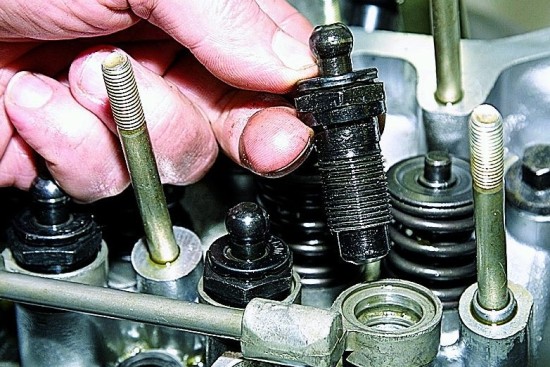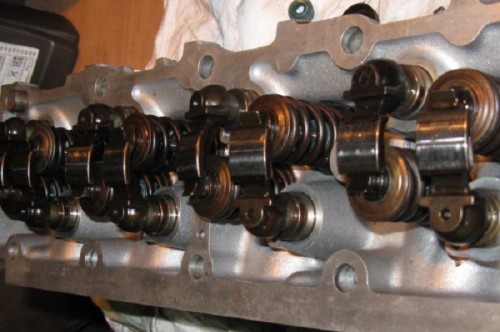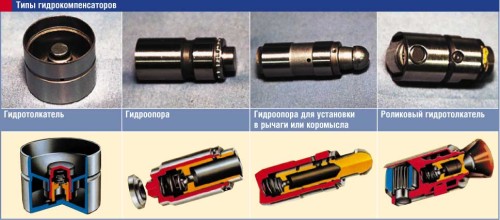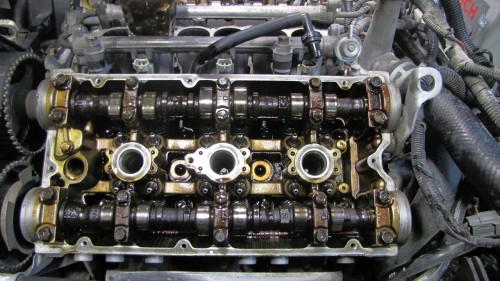With the problem of annoying knocking from under the hood, every driver can face. And it does not matter, domestic is a car or a foreign car. However, it is not necessary to panic - most likely your car is knocking hydrocompensators. The causes of such a knock may be somewhat.
In addition, the hydrocompensators can knock both on the cold and on the hot motor motor. Such a problem may occur not only on old cars with great mileage, but also on those who have just come down from the converable. However, it is not necessary to immediately run to the store for new details, as there are a lot of simple methods to eliminate the knock.
Content
Device of hydrocompensator
The hydrocompensor is called a device that adjusts the gaps of the motor valves. The engine is able to heat up during operation, which leads to the natural expansion of metal elements. Designers take into account such features and therefore create special thermal gaps. However, another feature of the motor is the gradual wear of the elements, which respectively expands the gaps and we see such negative moments as a decrease in compression, the gradual destruction of the engine elements, a reduction in power and increased fuel and oil consumption.
An important detail of any inner combustion gasoline motor is a gas-distribution system. Its main details:
1.Chis camshaft, which begins to rotate using the timing belt (gas distribution mechanism).
2. Valve pushers.
3. Graduation and intake valves.
4. The camshaft with cams are flowing on it.
Only basic details are listed here, in fact more than them. The essence of the operation of the TRM is the synchronous rotation of the camshaft with the crankshaft, alternated pressure of the cams on the pushers, which leads valves in motion.
There are several types of hydrocomathers:
1.Grottroller.
2. Roller hydrotrode.
3. Hydropar.
4. Hydropar for installation in a rocker or levers.
Under the influence of time between the pushers (rocker) and the working surfaces of the camshaft, the gaps are formed. Once for their compensation, a simple adjustment mode was used using wrench keys and special tags. Adjust the gaps needed almost every ten or fifteen thousand kilometers. To date, such a problem practically does not exist thanks to the creation and active use of hydrocomathers.
Although the hydrocompensators are of different species, mostly the principle of their action and the device are no different. Basic details of the hydraulic components:
1.Corpus.
2. Channel for income inside the oil compensator.
3. Plunger Couple - Plunger Bushing, Spring, Ball.
The hydrocompanator is mounted on a specially designated place in the head of the cylindrical block. In addition, they can be installed on old types of engines in which their installation was not provided.
The principle of operation of the hydrocompensator is quite simple. The camshaft cam has incorrect forms. When he does not press the pusher, the gap increases between them. At the same time, the plunger's valve presses the plunger spring and from the lubricant system inside the compensator comes out, which slightly lifts the work part of the hydrocompanator, the pusher leads in motion and the gap between the pusher and the cam disappears.
When the camshaft produces turnover and the cam begins to give a load on the pusher, the working part of the hydrocompensator is lowered to overlapping the oil intake channel. Thus, inside the compensator, the pressure is increasing and the motor valve rod is transmitted.
Thanks to the use of hydraulic components, it was possible to achieve several advantages of new engines in front of the old:
1. The camshaft and valves decreased the number of shock loads.
2. The operation of the motor has become more quiet and soft.
3. No longer need to make valve gaps every-time.
Causes of the vocabulary of the hydrocommovensector
The knock may occur in two situations - if the mechanics of the hydrocompensator are defective or the problem in the engine systems that are responsible for the supply of oil. A professional automotive mechanic can exactly determine the cause of the vocompensor knock.
For the reasons of the first species include:
1. Putting the elements of the hydrocompanator. This is due to the gradual inheritance of oil and fall into it foreign impurities.
2. Getting into the hydraulic air compensator. It occurs due to the low oil supply to the system.
3. Scoring the oil supply valve, which is why it can slide.
4. Factory marriage of some elements of the hydrocompensator.
5. Wear shock coverage plunger pair. As a result of the fact that under the influence of the camshaft camshaft time is capable of leaving dents on the working surface of the plunger.
The reasons for the second species include:
1. Motor removal, due to which the characteristics of the motor oil are changed.
2. Bad oil viscosity, quality or incorrect climatic conditions.
3. Failed an oil filter.
4. We were clogged by mud or naigar oil channels, by which oil comes into the hydrakompensator.
5. Availability in air oil. This may occur if the oil level in the motor is lower or higher than the optimal one.
As we have spoken above, the hydrocomathers are capable of knocking on cold and hot. A knock when a warm engine is treated, as a rule, has already been caused by its already spent its or poor-quality oil. In most cases, the problem can be easily solved, just a bay new quality engine oil. Also, pay attention to the oil filter. If it is dirty, you should replace it with a new one. If the malfunction remains, this indicates that the problem is not at all in the hydrocomathers. Look for the reason for the knock in other motor nodes.
If you hear a knock on the cold motor, it is not as critical. The fact is that the cold oil has a completely different viscosity than when heated. This is the cause of the knock on the immentable engine. The oil is simply not able to get inside the hydrocompensator. Most motorists do not pay attention to the knock if the engine is still cold.
What hydrocompensator knocks how to find out
For a professional or experienced driver, this is not difficult. As a rule, use acoustic diagnostics, which allows you to reveal with the maximum accuracy, which precisely the hydrocompanator makes a knock. After finding the knocking hydraulic compensator, it is necessary to wash it thoroughly, to build back and run the motor again. If the knock remained, check the quality of the oil or look for the reason in other motor nodes.
Consequences of malfunction
As it was written above, many motorists do not react to a knocking knock from under the hood, which is caused by hydrocompensators. And in vain. After all, barely audible knocks with time can grow more seriously.
Faulty hydraulic components can lead to a decrease in the operation of the drive timing and have a destructive slow effect on the head of the cylindrical block. But the cost of repairing these nodes leaves much to be desired.
Tips motorist
As for the repair of hydraulic compensators, only the owner of the vehicle can decide - to give a car into the hands of qualified specialists or eliminate the problem with their own hands. In addition, the diagnosis of the problem you can spend from the master and identify the causes of the breakdown. And then see, for example, if only washing the hydraulic compensator is needed, then you can easily cope. However, if necessary, more complex repairs of the node, it will be advisable for help to professionals. Because illiterate interference in the engine system can over time turn on considerable repairs. Very often much more profitable and easier to contact a special service immediately, where all work will be performed by knowledgeable people. To extend the life of the hydrocomathers and other parts of the engine, should not be saved on the quality of the oil and do not forget to change it.
Related Materials
- Stove 2110, bad warm stove 2110, VAZ 2110 heating system, repairing the heating system VAZ 2110 with their own hands
- VAZ 2114 stove blows with cold air, stove 2114, bad warm stove VAZ 2114, device and repair of heating VAZ 2114 do-it-yourself, removing the stove VAZ 2114
- How to subdominize the car. How to put a jack. Types of jacks for cars.
- VAZ 2109 Fuse Block, VAZ 2109 Fuse Block Carburetor, VAZ 2109 Fuse Block Injector, Old VAZ 2109 Fuse Block, VAZ 2109 Fuse Block, VAZ Fuse Block 2109
- Car exhaust gas catalyst, faulty catalyst, pluses and cons of the catalyst, how to change the catalyst on the planeencitel
- Stove blowing cold air VAZ 2114, badly blowing the stove VAZ 2114, why badly blowing the stove VAZ 2114
- How to find out the owner of the car by the number of his car, check the car by the number of the traffic police machine, check the car by the state number of the car for free
- How to choose Used tires, Useful Tips
- Winter car road, pressure in passenger car tires in winter, good battery for the car in winter, whether to warm the car in winter
- In winter, the car is poorly started. How to make a car in winter, do you need to warm up the car in winter, useful tips
- Economy fuel consumption machines, the most economical car consumption
- Tires brands for passenger cars, labeling of car tire labeling, residual passenger car tire protector, how to pick a tire on a car brand, car tire tread pattern
- Working transmission operation, mechanical gearbox clutch work, driving with manual gearbox, useful tips
- Rear beam Peugeot 206 sedan, rear beam device Peugeot 206. Rear beam Peugeot 206 Malfunction, repair of the rear beam Peugeot 206
- Diesel fuel in winter, additive for diesel fuel in winter, how to choose the best diesel fuel
- Diesel winter does not start. How to start diesel in winter, heating diesel in winter.
- Japanese bridgestone tires, winter studded bridgestone tires, bridgestone tires brand
- Tire marking decoding for passenger cars, labeling wheels, how to choose the right tires on the disks
- Diesel engine in winter, launch of the diesel engine in winter, what oil to fill in a diesel engine in winter, useful tips
- LED backlight of the car, the backlight of the bottom of the car, the backlight of the legs in the car, the backlight in the door of the car, the backlight of the car is fine
- Recovered tires, bus tire, restored tire protector, can I use them
- Choose winter tires, which is a winter tires, which pressure in winter tires should be marked with winter tires, how to choose the right winter tires, the best winter tires 2019
- Steering rail rail, knock of steering rack, reasons for the knock and repair of the steering rack do it yourself
- Cameless car tires, a set for repair of tubeless tires, repair of the cannon-free tire do it yourself
- Russian tires, Russian tires Winter, Russian All-season tires, Voronezh AMTEL tires, Tires "Matador Omsk Tire", Kama-tires are world-class bus
- How to open a car without a key. Lost the key from the car what to do, the key from the car inside the car
- Silent tires, quiet winter tires, quiet studded bus, which tires to choose, overview tires
- Tires and safety, safety of the bus, why it is necessary to constantly monitor car tires
- Rules of safe driving of the car in the rain and slush, safe driving of the car for beginners
- Rust converter which is better for cars, rust converters to choose how to use rust transducer, professionals
- Polishing the body of the car do it yourself, how to choose a polishing paste, useful tips
- Engine durability, engine life, how to extend engine life
- Knock in the car. Knock when moving the car. What can knock in the car. How to determine the cause of the knock.
- ABS car, what is ABS car, ABS system malfunction, ABS diagnostics
- Overtaking a car when you can start overtaking a car, rules of traffic rules
- Fuel pump VAZ 2110, VAZ 2110 gas station scheme, VAZ 2110 fuel pump device, VAZ 2110 gas station repair,
- Automotive antennas for radio, automotive antenna device, car antenna do it yourself
- Front suspension Kalina, device front suspension Kalina, knock in front suspension Kalina, repair of front suspension Kalina
- Shock absorber Oil, best oil shock absorbers, pumping oil shock absorbers, how to properly pump oil shock absorber
- Clutch malfunctions, touches clutch, causes a clutch malfunction, how to eliminate










Comments